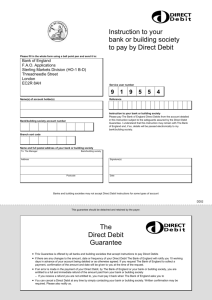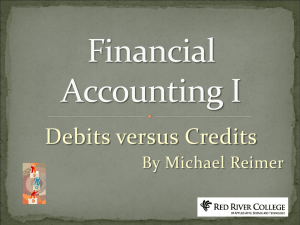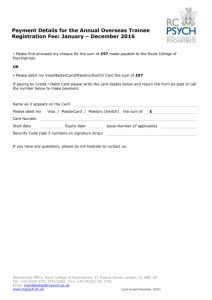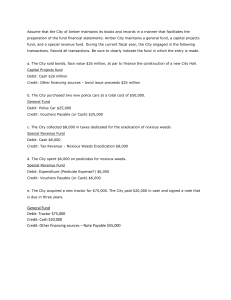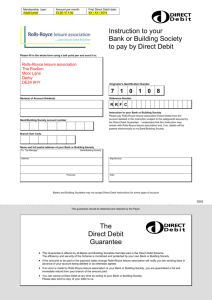ExamView Pro - Second Semester Final 2014.tst
advertisement
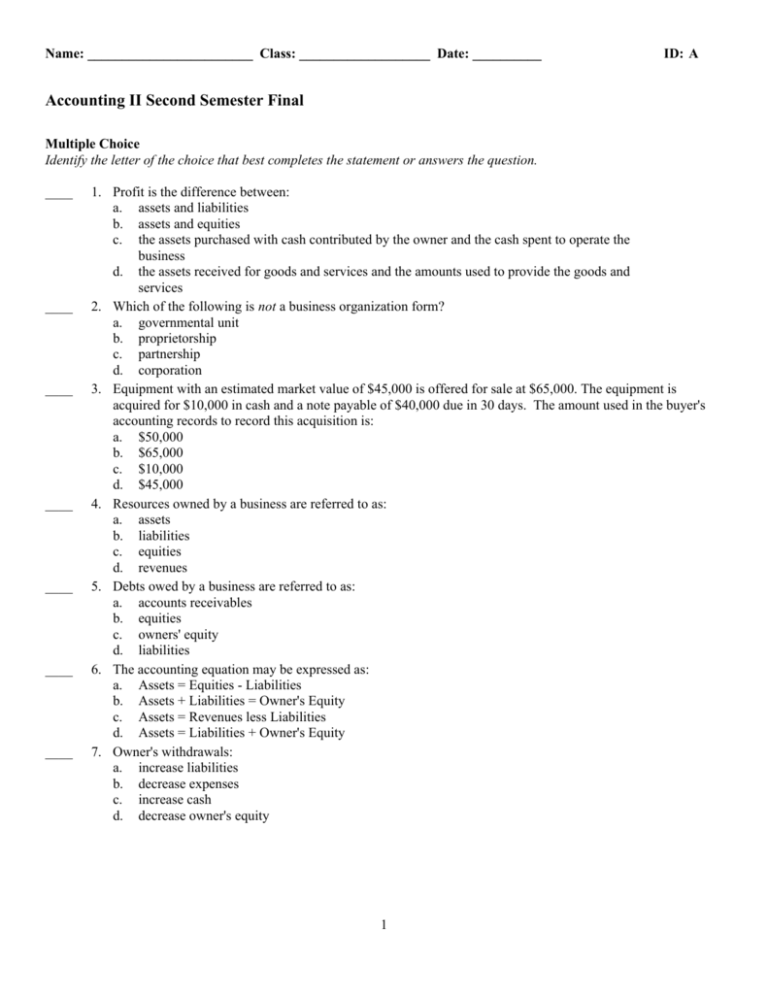
Name: ________________________ Class: ___________________ Date: __________ ID: A Accounting II Second Semester Final Multiple Choice Identify the letter of the choice that best completes the statement or answers the question. ____ ____ ____ ____ ____ ____ ____ 1. Profit is the difference between: a. assets and liabilities b. assets and equities c. the assets purchased with cash contributed by the owner and the cash spent to operate the business d. the assets received for goods and services and the amounts used to provide the goods and services 2. Which of the following is not a business organization form? a. governmental unit b. proprietorship c. partnership d. corporation 3. Equipment with an estimated market value of $45,000 is offered for sale at $65,000. The equipment is acquired for $10,000 in cash and a note payable of $40,000 due in 30 days. The amount used in the buyer's accounting records to record this acquisition is: a. $50,000 b. $65,000 c. $10,000 d. $45,000 4. Resources owned by a business are referred to as: a. assets b. liabilities c. equities d. revenues 5. Debts owed by a business are referred to as: a. accounts receivables b. equities c. owners' equity d. liabilities 6. The accounting equation may be expressed as: a. Assets = Equities - Liabilities b. Assets + Liabilities = Owner's Equity c. Assets = Revenues less Liabilities d. Assets = Liabilities + Owner's Equity 7. Owner's withdrawals: a. increase liabilities b. decrease expenses c. increase cash d. decrease owner's equity 1 Name: ________________________ ____ ID: A 8. The total assets and the total liabilities of a business at the beginning and at the end of the year appear below. During the year, the owner had withdrawn $50,000 for personal use and had made an additional investment of $35,000 in the business. Assets $295,000 355,000 Beginning of year End of year ____ 9. ____ 10. ____ 11. ____ 12. ____ 13. ____ 14. ____ 15. Liabilities $190,000 220,000 The amount of net income for the year was: a. $85,000 b. $40,000 c. $135,000 d. $45,000 Which of the following accounts is an asset account? a. Salaries Expense b. Drawing c. Accounts Payable d. Cash The debit side of an account: a. depends on whether the account is an asset, liability or owner's equity b. can be either side of the account depending on how the accountant set up the system c. is the right side of the account d. is the left side of the account Which of the following types of accounts have a normal credit balance? a. Drawing b. Assets c. Expense d. Liability A credit signifies a decrease in: a. drawing b. liabilities c. capital d. revenue Which of the following describes the classification and normal balance of the accounts receivable account? a. Asset, debit b. Liability, credit c. Owner's equity, credit d. Revenue, credit The classification and normal balance of the supplies expense account is a(n): a. asset with a debit balance b. asset with a credit balance c. expense with a debit balance d. liability with a credit balance Which of the following entries records the investment of cash by Funaro, owner of a proprietorship? a. debit Funaro, Capital; credit Accounts Receivable b. debit Cash; credit Funaro, Capital c. debit Funaro, Drawing; credit Cash d. debit Cash; credit Funaro, Drawing 2 Name: ________________________ ID: A ____ 16. Cash was paid by J's Appliance Repair to creditors on account. Which of the following entries for J's records this transaction? a. Cash, debit; J's, Capital, credit b. Accounts Payable, debit; Cash, credit c. Accounts Receivable, debit; Cash, credit d. Accounts Payable, debit; Account Receivable, credit ____ 17. Which of the following entries records the receipt of cash from patients on account? a. Accounts Payable, debit; Fees Earned, credit b. Accounts Receivable, debit; Fees Earned, credit c. Accounts Receivable, debit; Cash, credit d. Cash, debit; Accounts Receivable, credit ____ 18. The process of rewriting the information from the journal into the ledger is called: a. sliding b. transposing c. journalizing d. posting ____ 19. An overpayment error was discovered in computing and paying the wages of a Bartson Repair Shop employee. When Bartson receives cash from the employee for the amount of the overpayment, which of the following entries will Valor make? a. Cash, debit; Wages Expense, credit b. Wages Payable, debit; Wages Expense, credit c. Wages Expense, debit, Cash, credit d. Cash, debit; Wages Payable, credit ____ 20. Using accrual accounting, revenue is recorded and reported only: a. when cash is received without regard to when the services are rendered b. when the services are rendered without regard to when cash is received c. when cash is received at the time services are rendered d. if cash is received after the services are rendered ____ 21. Using accrual accounting, expenses are recorded and reported only: a. when they are incurred, whether or not cash is paid b. when they are incurred and paid at the same time c. if they are paid before they are incurred d. if they are paid after they are incurred ____ 22. Accrued expenses have: a. not yet been incurred, paid, or recorded b. been incurred, not paid, but have been recorded c. been incurred, not paid, and not recorded d. been paid but have not yet been incurred ____ 23. Adjusting entries are: a. the same as correcting entries b. needed to bring accounts up to date and match revenue and expense c. optional under generally accepted accounting principles d. rarely needed in large companies ____ 24. The balance in the prepaid rent account before adjustment at the end of the year is $20,000, which represents four months' rent paid on December 1. The adjusting entry required on December 31 is: a. debit Rent Expense, $15,000; credit Prepaid Rent, $15,000 b. debit Prepaid Rent, $15,000; credit Rent Expense, $15,000 c. debit Rent Expense, $5,000; credit Prepaid Rent, $5,000 d. debit Prepaid Rent, $5,000; credit Rent Expense, $5,000 3 Name: ________________________ ID: A ____ 25. The balance in the office supplies account on June 1 was $5,200, supplies purchased during June were $2,500, and the supplies on hand at June 30 were $2,000. The amount to be used for the appropriate adjusting entry is: a. $4,500 b. $2,500 c. $9,700 d. $5,700 ____ 26. The balance in the prepaid insurance account before adjustment at the end of the year is $10,000. If the additional data for the adjusting entry is (1) "the amount of insurance expired during the year is $8,500," as compared to additional data stating (2) "the amount of unexpired insurance applicable to a future period is $1,500," for the adjusting entry: a. the debit and credit amount for (1) would be the same as (2) but the accounts would be different b. the accounts for (1) would be the same as the accounts for (2) but the amounts would be different c. the accounts and amounts would be the same for both (1) and (2) d. there is not enough information given to determine the correct accounts and amounts ____ 27. The difference between the balance of a fixed asset account and the related accumulated depreciation account is termed: a. historical cost b. contra asset c. book value d. market value ____ 28. The net income reported on the income statement is $90,000. However, adjusting entries have not been made at the end of the period for supplies expense of $2,500 and accrued salaries of $3,400. Net income, as corrected, is: a. $84,100 b. $96,600 c. $90,000 d. $97,500 ____ 29. One of the accounting concepts upon which deferrals and accruals are based is: a. matching b. cost c. price-level adjustment d. conservatism ____ 30. The supplies account has a balance of $500 at the beginning of the year and was debited during the year for $2,900, representing the total of supplies purchased during the year. If $750 of supplies are on hand at the end of the year, the supplies expense to be reported on the income statement for the year would be: a. $1,650 b. $2,150 c. $2,400 d. $2,650 ____ 31. Which of the following appears in the Balance Sheet columns of the work sheet? a. Unearned Fees b. Rent Expense c. Salaries Expense d. Service Revenue 4 Name: ________________________ ID: A ____ 32. After all of the account balances have been extended to the Balance Sheet columns of the work sheet, the totals of the Debit and Credit columns are $39,750 and $21,750, respectively. What is the amount of net income or net loss for the period? a. $18,000 net income b. $18,000 net loss c. $39,750 net income d. $21,750 net income ____ 33. Accumulated Depreciation appears on the: a. balance sheet b. statement of owner's equity c. income statement d. statement of cash flows ____ 34. Notes Receivable due in 350 days appears on the: a. balance sheet in the current assets section b. balance sheet in the fixed assets section c. balance sheet in the current liabilities section d. income statement as an expense ____ 35. Closing entries: a. need not be journalized if reversing entries are prepared b. need not be posted if the financial statements are prepared from the work sheet c. are not needed if adjusting entries are prepared d. must be journalized and posted ____ 36. Which of the following accounts will not be closed to Income Summary at the end of the fiscal year? a. Salaries Expense b. Fees Earned c. Unearned Rent d. Depreciation Expense ____ 37. Which of the following accounts appears on a post-closing trial balance? a. Insurance Expense b. Fees Earned c. Drawing d. Unearned Fees ____ 38. The difference between sales and cost of merchandise sold for a merchandising business is: a. Sales b. Net Sales c. Gross Sales d. Gross Profit ____ 39. The primary difference between a periodic and perpetual inventory system is that a: a. periodic system determines the inventory on hand only at the end of the accounting period b. periodic system keeps a record showing the inventory on hand at all times c. periodic system provides an easy means to determine inventory shrinkage d. periodic system records the cost of the sale on the date the sale is made ____ 40. When a buyer returns merchandise purchased for cash, the buyer may record the transaction using the following entry: a. debit Merchandise Inventory; credit Cash b. debit Cash; credit Merchandise Inventory c. debit Cash; credit Sales Returns and Allowances d. debit Sales Returns and Allowances; credit Cash 5 Name: ________________________ ID: A ____ 41. In credit terms of 1/10, n/30, the "1" represents the: a. number of days in the discount period b. full amount of the invoice c. number of days when the entire amount is due d. percent of the cash discount ____ 42. Sales to customers who use bank credit cards, such as MasterCard and Visa, are generally treated as: a. sales on account b. sales returns c. cash sales d. sales when the credit card company remits the cash ____ 43. Which of the following accounts has a normal credit balance? a. Sales Returns and Allowances b. Sales c. Merchandise Inventory d. Transportation Out ____ 44. Accompanying the bank statement was a debit memorandum for bank service charges. What entry is required in the depositor's accounts? a. debit Miscellaneous Administrative Expense; credit Cash b. debit Cash; credit Other Income c. debit Cash; credit Accounts Payable d. debit Accounts Payable; credit Cash ____ 45. The type of account and normal balance of Petty Cash is a(n): a. revenue, credit b. asset, debit c. liability, credit d. expense, debit ____ 46. The following lots of a particular commodity were available for sale during the year: Beginning inventory........ First purchase............. Second purchase............ Third purchase............. 10 25 30 15 units units units units at at at at $50 $53 $54 $60 The firm uses the periodic system and there are 20 units of the commodity on hand at the end of the year. What is the amount of inventory at the end of the year according to the first-in, first-out method? a. $1,030 b. $1,140 c. $1,170 d. $1,060 6 Name: ________________________ ID: A ____ 47. The following lots of a particular commodity were available for sale during the year: Beginning inventory........ First purchase............. Second purchase............ Third purchase............. 10 25 30 10 units units units units at at at at $60 $63 $64 $70 The firm uses the periodic system and there are 20 units of the commodity on hand at the end of the year. What is the amount of inventory at the end of the year according to the last-in, first-out method? a. $1,230 b. $1,220 c. $1,240 d. $1,340 ____ 48. During a period of consistently rising prices, the method of inventory that will result in reporting the greatest cost of merchandise sold is: a. fifo b. lifo c. average cost d. weighted average ____ 49. On June 5, Apex Co. issued an $80,000, 8%, 120-day note payable to Jones Co. Assume that the fiscal year of Jones Co. ends June 30. What is the amount of interest revenue recognized by Jones in the following year? a. $888.88 b. $1,600.00 c. $1,688.89 d. $2,133.00 ____ 50. Jeremy Co. issued a $25,000, 60-day, discounted note to River City Bank. The discount rate is 9%. The cash proceeds to Jeremy Co. are: a. $25,375 b. $25,000 c. $22,750 d. $24,625 7 ID: A Accounting II Second Semester Final Answer Section MULTIPLE CHOICE 1. 2. 3. 4. 5. 6. 7. 8. 9. 10. 11. 12. 13. 14. 15. 16. 17. 18. 19. 20. 21. 22. 23. 24. 25. 26. 27. 28. 29. 30. 31. 32. 33. 34. 35. 36. 37. 38. 39. 40. D A A A D C D D D D D A A C B B D D A B A C B C D C C A A D A A A A D C D D A B 1 ID: A 41. 42. 43. 44. 45. 46. 47. 48. 49. 50. D C B A B C A B C D 2


